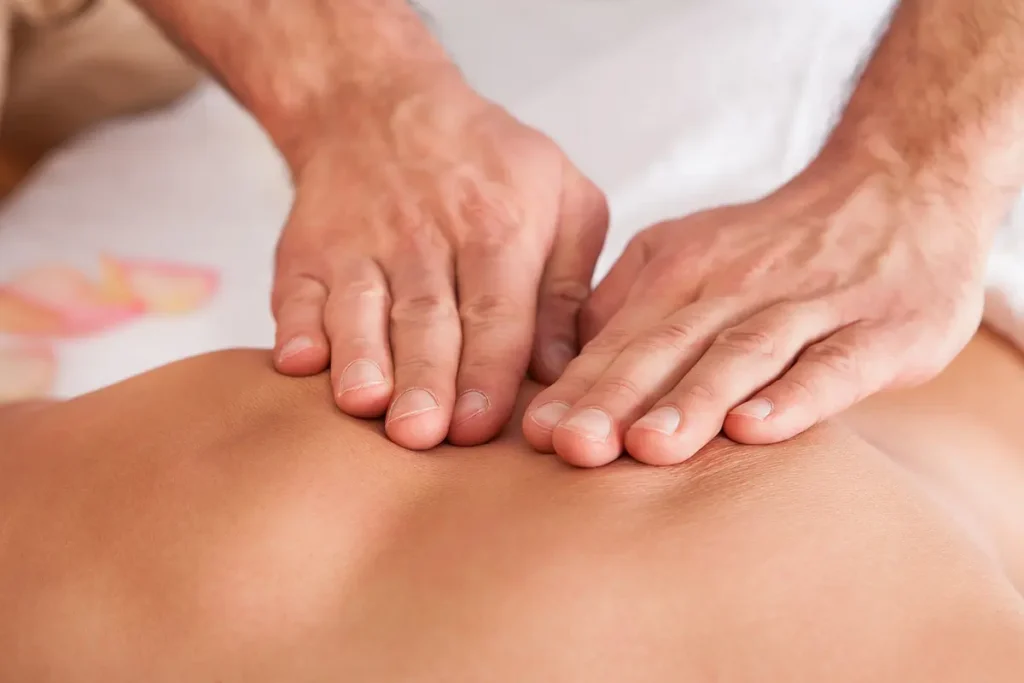Deep tissue massage focuses on realigning deeper layers of muscles and connective tissue.
It is especially beneficial for those experiencing chronic pain, muscle tension, or recovering from injuries.
Its popularity has surged due to its effectiveness in alleviating various musculoskeletal issues and enhancing overall well-being.
What is Deep Tissue Massage?

Source:facebook.com
Deep tissue massage targets the deeper layers of muscle and fascia (the connective tissue surrounding muscles).
Unlike Swedish, which typically focuses on relaxation, deep tissue massage aims to release chronic muscle tension and adhesions, also known as “knots.”
This type involves slow strokes and deep finger pressure on the affected areas, either following or going across the fibers of the muscles, tendons, and fascia.
A distinguishing feature is its intensity. It uses more pressure compared to other techniques and can sometimes cause discomfort as it works on relieving muscle tension. However, this discomfort is often described as a “good pain” that leads to significant relief.
In places like Sokcho massage (속초마사지), therapists are trained to deliver effective deep tissue massages that cater to individual needs, ensuring that each session is both therapeutic and relaxing.
What are the Benefits?
Now let us talk about the benefits.
Pain Relief
One of the primary benefits of deep tissue massage is its ability to provide relief from chronic muscle pain. Individuals suffering from conditions such as lower back pain, fibromyalgia, or repetitive strain injuries can find significant relief through regular deep tissue massage sessions.
By breaking down scar tissue and adhesions, this massage technique helps improve blood flow and oxygenation to the affected areas, promoting healing and reducing pain.
Reduces Inflammation

Source: forbes.com
Deep tissue massage is effective in reducing inflammation and the associated symptoms. Inflammation can lead to chronic pain and discomfort, and by targeting the deeper layers of muscles, this technique helps reduce inflammation and promote faster recovery.
The increased circulation brought about by deep tissue massage aids in flushing out toxins and bringing in fresh nutrients, which helps in the healing process.
Improves Posture
Poor posture often results from muscle imbalances and tension. It helps correct these imbalances by releasing tension in the muscles and improving alignment.
By targeting the deeper muscle layers, this massage technique helps restore the natural posture, reducing the strain on the body and preventing future postural issues.
Releases Chronic Muscle Tension
Chronic muscle tension can lead to various health issues, including pain, reduced mobility, and poor posture. It is highly effective in releasing built-up tension in the muscles, promoting relaxation and improved function. This technique helps break down adhesions and scar tissue, which can restrict movement and cause pain.
Breaks Up Scar Tissue
Scar tissue can form after injuries or surgeries, leading to stiffness and pain. Deep tissue massage helps break up this scar, promoting flexibility and reducing discomfort. By applying deep pressure and specific techniques, therapists can help improve the texture and elasticity of the affected tissues.
Increases Joint Flexibility and Range of Motion
Enhancing joint flexibility and range of motion is another significant benefit of deep tissue. By targeting the deeper muscles and connective tissues, this technique helps improve overall mobility, making it easier to perform daily activities and engage in physical exercise.
Reduces Stress and Anxiety

Source: zendayspa.com.au
Stress and anxiety can manifest physically as muscle tension and discomfort. Deep tissue massage helps alleviate these symptoms by promoting relaxation and reducing muscle tension. The slow, deliberate strokes used in this massage technique help calm the nervous system and promote a sense of well-being.
Improves Circulation
Improved circulation is one of the key benefits. By enhancing blood flow and oxygen supply to the muscles, this technique helps promote healing and reduce muscle fatigue. Better circulation also aids in the removal of toxins and metabolic waste from the body.
Reduces Headaches
Tension headaches are often caused by tight muscles in the head, neck, and shoulders. Deep tissue massage helps ease this tension, providing relief from headaches. By targeting the deeper layers of muscles, this technique helps reduce pain and discomfort in the affected areas.
Assists with Recovery
Deep tissue massage is beneficial for individuals recovering from surgeries or injuries. By promoting better circulation and breaking down scar tissue, this massage technique helps speed up the recovery process and improve overall function.
What to Expect During a Deep Tissue Massage

Source: theconnaught.co.uk
Before the massage begins, you will have an initial consultation with the therapist to discuss your goals, medical history, and areas of concern. This helps the therapist understand your specific needs and tailor the massage accordingly.
During a deep tissue massage, the therapist will use a variety of techniques, such as stripping (gliding pressure along the length of the muscle fibers) and friction (rubbing against the grain of the muscle). The pressure applied is deeper and more intense compared to other massage techniques, which helps target the deeper layers of muscles and connective tissues.
It is common to experience some soreness. The therapist will provide recommendations for post-massage care, such as staying hydrated and applying ice to the affected areas to reduce any inflammation. Proper aftercare is essential to maximize the benefits of the massage and promote faster recovery.
Who Can Benefit from It?
Deep tissue massage can be beneficial for a wide range of individuals, including athletes, people with chronic pain conditions (such as fibromyalgia and arthritis), individuals with postural issues, and patients recovering from surgeries or injuries. By addressing deep muscle tension and promoting overall well-being, this massage technique can help improve quality of life for many people.
Precautions and When to Avoid Deep Tissue Massage
While deep tissue massage offers numerous benefits, it is not suitable for everyone. Individuals with certain medical conditions, such as blood clots, recent surgeries, or infections, should avoid it. It is important to consult with a qualified therapist and your healthcare provider to determine if it is appropriate for your specific condition.
How Often Should You Get a Deep Tissue Massage?
The frequency of deep tissue massage sessions depends on individual needs and goals. For chronic pain relief, regular sessions (such as once a week) may be recommended. Athletes seeking to enhance performance might benefit from more frequent massages, while those looking to manage stress and anxiety might opt for less frequent sessions. It is best to consult with your therapist to develop a personalized plan that meets your needs.




